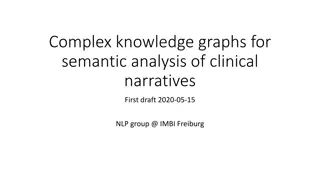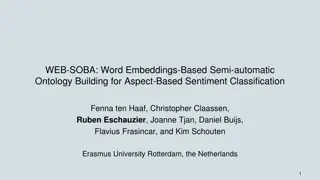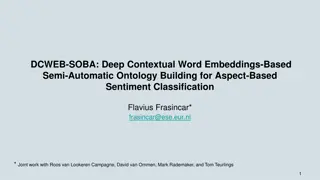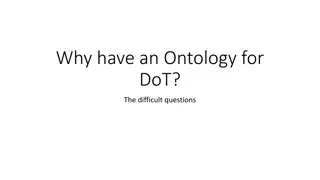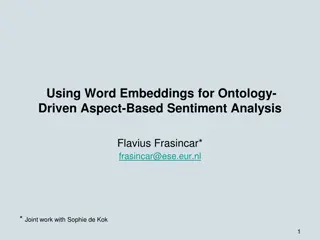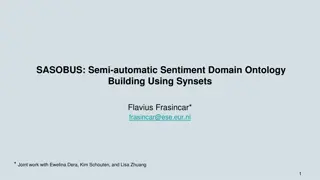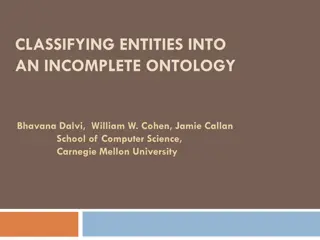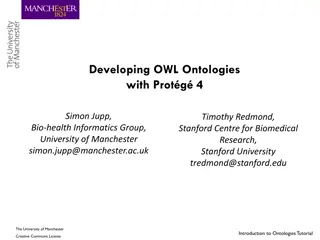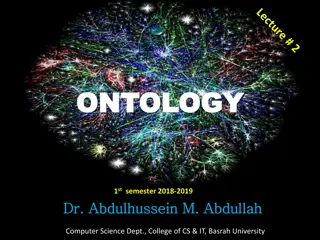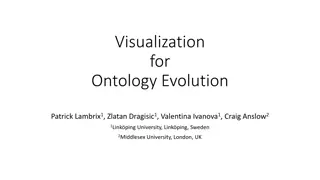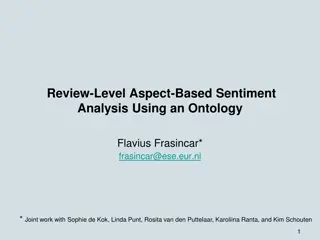Introduction to Ontology
The evolution of ontology from Carnap's logical positivism to Quine's revival of metaphysics, reshaping the landscape of analytic philosophy. Quine's method for serious ontology challenges traditional views on existence, incorporating scientific theory and logical analysis to explore the nature of reality.
Uploaded on Feb 17, 2025 | 0 Views
Download Presentation

Please find below an Image/Link to download the presentation.
The content on the website is provided AS IS for your information and personal use only. It may not be sold, licensed, or shared on other websites without obtaining consent from the author.If you encounter any issues during the download, it is possible that the publisher has removed the file from their server.
You are allowed to download the files provided on this website for personal or commercial use, subject to the condition that they are used lawfully. All files are the property of their respective owners.
The content on the website is provided AS IS for your information and personal use only. It may not be sold, licensed, or shared on other websites without obtaining consent from the author.
E N D
Presentation Transcript
Introduction to Ontology From Carnap and Quine to Hilary Putnam @emanuelrutten VU University Material in this course-presentation is primarily obtained from A. L. Thomasson s essay Carnap and the Prospects for Easy Ontology and from essays from H. Price, J. Schaffer and S. Soames in Metametaphysics: New Essays on the Foundations of Ontology (MM)
The anti-metaphysical movement By the late 1940s logical positivism or logical empiricism represented the furtherest advance of the anti-metaphysical movement Logical positivists launched the verification criterion. Empirical verifiable statements are cognitively meaningful, empirical unverifiable statements are cognitively meaningless The chief architect of logical positivism was Rudolf Carnap. He had a puritanical devotion to empiricism, and offered a radical deflationary view of metaphysics According to this view all questions of traditional a priori metaphysics are pseudo-questions. They lack cognitive content (and can t therefore be objects of thought or assertion) So, by the late 1940s metaphysics was supposed to be on its last legs. Actually, it was supposed to be dead. One believed to have finished what Kant started [Huw Price in MM]
The revival of metaphysics Yet, Carnap s position was never consolidated. In fact, the ground was lost For one of the features of contemporary analytic philosophy that Carnap would have found most surprising is the apparent health of metaphysics or ontology How come, the reader may wonder, it is precisely in analytic philosophy - a kind of philosophy that, for many years, was hostile to the very word ontology that ontology flourishes? If we ask when ontology became a respectable subject for an analytic philosopher to pursue, the mystery disappears. It became respectable in 1948, when Quine published a famous paper On What There Is . It was Quine who single handedly made ontology a respectable subject again. (Putnam in 2004) According to Putnam it was Quine perhaps Quine alone who rescued metaphysics. His On What There is gave Ontology a life-saving transfusion [Huw Price in MM]
Quines method for doing serious Ontology On the now dominant Quinean view, metaphysics is about what there is. Do properties exist? Do numbers exist? Do meanings exist? Do tables and chairs exist? Do temporal parts exist? Mereological sums? Propositions? Etc. Quine s four-stage indispensability method for doing serious ontology (1) Identify the best scientific theory (physics for Quine) (2) Identify the canonical logic (first order predicate logic for Quine) (3) Translate the best theory into the canonical logic (some paraphrasing allowed) (4) Determine the ontological commitments required to render this translation true Example: The indispensability of mathematics to empirical science gives us good reason to believe in the existence of mathematical entities. Reference to mathematical entities such as numbers is indispensable to our best scientific theories, and so we ought to be committed to the existence of these entities (Quine-Putnam indispensability argument) [(J. Schaffer in) MM]
Carnap is a Platonist according to Quine On Quine s view of doing serious Ontology Carnap is in fact a Platonist (!), since Carnap is in his logical-empirical theories committed to the existence of numbers, properties and other abstract objects Quine himself also recognizes the existence of numbers as a regrettable form of Platonism they are apparently unavoidable in our best physical theory. The same cannot be said, Quine thinks, for properties and other abstracta But how could Quine have called Carnap a Platonist? Platonism is among the traditional metaphysical views Carnap had consistently dismissed as cognitive meaningless nonsense. His Logical Empiricism was supposed to leave traditional metaphysics behind If someone as sympathetic to positivism as Quine could read Platonism into his project, Carnap would have to state his position more cleary. This was the task of his 1950 article Empiricism, Semantics, and Ontology [S. Soames in MM]
Carnaps deflationary view of metaphysics: ontology is shallow instead of substantive There are two kinds of questions concerning the existence of entities: internal questions and external questions Internal questions are questions of the existence of certain entities within a given linguistic framework of terms and rules for applying these terms Empirical internal questions: Is there a white piece of paper on my desk? (asked within the language for ordinary things - the thing language ) Analytical internal questions: Is there a prime number greater than 100? (asked within the language for natural numbers - the system of natural numbers ) Answers to specific internal existence questions are found straightforwardly by the analytical (e.g., mathematics) or empirical (e.g., looking) rules of the framework, depending on whether the framework is a logical or factual one Answers to general internal existence questions are found easily as well, by direct entailment from the specific existence assertions. For example: Five is a number entails Numbers exist or Red is a color entails Colors exist [A. Thomasson]
Carnaps deflationary view of metaphysics: ontology is shallow instead of substantive (cont.) External existence questions are questions of the existence of certain entities simpliciter, that is to say, apart from any given linguistic framework The terms in these questions are thus divorced from framework application rules (semantic rules) that govern their usage and constitute their meaning As a result external questions are cognitively meaningless pseudo-questions that can t be answered Traditional metaphysicians offer lengthy philosophical arguments for their claims, such as that numbers exist. So they cannot have in mind the rather trivially answerable internal existence questions The sense in which traditional metaphysical questions are raised must therefore be external. But then all questions from traditional metaphysics are ill-formed unintelligible pseudo questions Hence, neither the Nominalist s nor the Platonist s answer to the question Do numbers exist? , taken as an external question, should be embraced. Ontology as the practice of answering external existence questions is simply futile [A. Thomasson]
Carnaps deflationary view of metaphysics: ontology is shallow instead of substantive (cont.) External existence questions as theoretical or factual questions are thus meaningless. One should not ask what reallyexists. For that is senseless And that is why Carnap cannot be called a Platonist after all But external existence questions can still be raised as practical questions, that is, as pragmatic questions about whether or not to use some linguistic framework for a specific practical purpose Pragmatic external questions do have theoretical or factual aspects. For it is a factual matter whether for example a framework of things (enabling us to speak of e.g. atoms) is - or is not - more effective for doing empirical research than a minimalistic phenomenological framework (allowing talk of sense data only) Ontology becomes thus shallow in the sense that it is limited to conceptual engineering , that is, making practical decisions about the advisability of adopting and using certain linguistic frameworks for specific goals [MM &Thomasson]
Carnaps internal-external distinction in terms of the use-mention distinction Legitimate uses of the terms such as number and material object must be internal, for it is conformity to the rules of the framework in question that constitutes use. But as internal questions, as Carnap notes, these questions could not have the significance that traditional metaphysics take them to have. Metaphysics tries to locate them somewhere else, but thereby commits a use-mention fallacy. The only legitimate external questions simply mention the terms in question (Huw Price) Internal questions are asked within or using the framework. They make use of the relevant terms (property terms, number terms, material object terms) according to the framework rules of application. With those rules we can easily evaluate the truth of existential sentences containing those terms. The usage of terms is governed by rules, and therefore we must be using a framework to ask existential questions Without those rules the terms can therefore not be used. And that s why factual external existence questions are meaningless Without those rules these terms can only be mentioned as part of the practical question of whether we should adopt the terms numbers, properties, etc. - in our framework [A. Thomasson]
Does Carnaps deflationism entail anti-realism? According to an anti-realist there is no objective fact of the matter as to whether e.g. material things, properties or numbers exist. These questions are similar to questions like What is up? or Is Tom Cruise short? Hence, anti-realists take it that what there is depends on the framework we adopt. Existence is (like shortness or up ) inherently framework-relative Carnap s deflationism doesn t force us to say that what exists depends on the linguistic framework adopted. We can answer questions about whether this or that sort of entity exists but to ask these questions we must necessarily be using some language, i.e., some linguistic framework that establishes the application rules for the terms used in asking and answering these questions We thus cannot ask anything apart from a framework. Nevertheless, and this is crucial (!), the answers we express using some framework may still be true. Anti- realism does not necessarily follow. There might be an objective fact of the matter as to what there is. Some linguistic frameworks might be right [MM]
Hilary Putnams deflationism It is characteristic [...] to hold that What objects does the world consists of? is a question that only makes sense to ask within a theory of description. (Putnam 1981) There is no God s Eye point of view that we can know or usefully imagine; there are only the various points of view of actual persons reflecting various interests and purposes that their descriptions and theories subserve. (Putnam 1981) Putnam argues for conceptual relativity. The question what exists can only be answered in terms of a particular version , i.e., a particular conceptual scheme or representational system. Questions asked outside all versions are rejected So far Carnap would have said the same: the question what exists can only be answered internal to a linguistic framework i.e., using a framework. Factual existence questions external to a linguistic framework are rejected But there are two ways in which Putnam s deflationism takes a different turn (1) The meaning of the core terms exists and object itself differs in different versions (2) Putnam embraces anti-realism, that is to say, he denies Realism [A. Thomasson]
(1) The meaning of exists is framework-relative [ ] the phenomenon of conceptual relativity [ ] turns on the fact that the logical primitives themselves, and in particular the notions of object and existence, have a multitude of different uses rather than one absolute meaning (Putnam, 1987) (1) is called quantifier variance, i.e. the idea that there is no single core meaning for existence or there is Carnap disagrees. For him exists is a topic neutral and formal term that may be conjoined with material terms of different categories (things, numbers, etc.) while retaining the same core sense (the same core rules of use) That is, exists is univocal. It has a single core meaning. It s meaning does not change (except from some analytic rules, e.g. 5 is a number ) when we add new terms (such as number ) to the framework language Illustrations of the univocacy of exists X s exist iff the number of X s is larger than zero (Van Inwagen) X s exist iff not everything is not-X ( ) X s exist iff X refers (Horwich) [A. Thomasson]
An example to clarify (1) Take a Platonist and a Nominalist with respect to the existence of numbers Putnam would say that exists in the conceptual scheme of the Platonist has a different core meaning from exists in the conceptual scheme of the Nominalist Therefore, the Platonist can within his scheme truly say Numbers exist , whereas the Nominalist can in his scheme truly say Numbers do not exist . Both accept the term number in their scheme. They also agree on what numbers are. The reason for their difference is that they attribute a different meaning to exist (different truth-conditions for existence) Carnap would handle this case quite differently. He holds that exists is univocal. So the Platonist and Nominalist do not disagree on the meaning of exists [A. Thomasson]
An example to clarify (1) [cont.] They differ on which material terms ( sortals ) to adopt in their schemes. -- The Platonist adopts the term number (he will say 4 is a number , which entails There are numbers ). -- The Nominalist refuses to adopt the term number (he never uses the term number in his sentences. But he may still say things like There are two cars ) Indeed, IF the Nominalist would also have adopted the term number (together with its analytical rules of use) THEN he would have trivially accepted that numbers exist! Therefore, the dispute between the Platonist and Nominalist is merely pragmatic. Should we (given the purpose at hand) add the term number to our language? [A. Thomasson]
(2) Putnams anti-realism Putnam believes that quantifier variance is a good reason for accepting anti- realism What is wrong with the notion of objects existing independently of conceptual schemes is that there are no standards for the use of even the logical notions apart from conceptual choices (Putnam, 1987) [ ] the idea that there is an Archimedean point, or a use of exist inherent in the world itself, from which the question How many objects really exist? makes sense, is an illusion. (Putnam, 1987) Putnam thus concludes that we must reject the idea that there are objects that exist independently of our conceptual scheme In short, he denies Realism: -- The world consists in a fixed totality of mind-independent objects -- There is one complete description that corresponds to the way the world is As we have seen Carnap s deflationism doesn t force us to accept anti-realism either [A. Thomasson]
So, why did Carnapian deflationism loose ground? Was it indeed Quine in 1948, as Putnam himself maintained in 2004? According to Amie L. Thomasson it was primairly due to Putnam himself, and others who linked Carnap s deflationism to quantifier variance and anti-realism For by doing so Putnam and others made Carnap s position quite unattractive for metaphysicians http://t1.gstatic.com/images?q=tbn:ANd9GcQjUGIr3PZ7Fq9-TLG9mWGrb1Yf0Y-f65YdA3ERL-1rB3cDvMf1IA http://t1.gstatic.com/images?q=tbn:ANd9GcQQGoRh85z-40R6ixpxP4BT-WpE0tm_oow8crHqkMV-2oPzTH0n [A. Thomasson]


